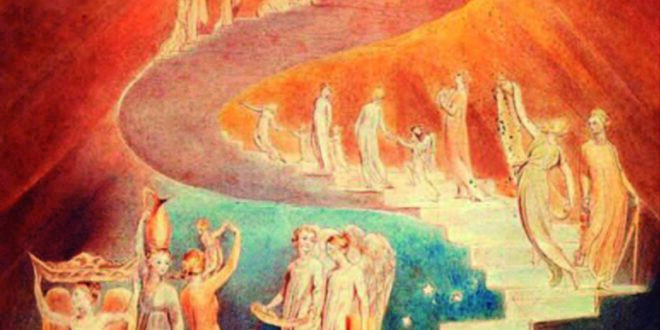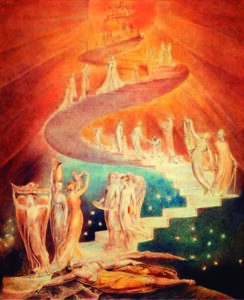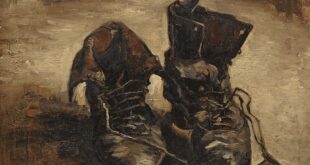Coordinador: Carlos Guido Musso
Doctor en Medicina por la Universidad de Salamanca, España.
Profesor de Humanidades Médicas. Instituto Universitario del Hospital Italiano de Buenos Aires.
Acta Gastroenterol Latinoam 2020;50(3):228-231
Publicado en www.actagastro.org el 28/09/2020
Introducción
El arte, con su lenguaje de imágenes (simbólico), logra trasmitir las ideas de manera directa, prescindiendo de la palabra, y evitando de esta forma la reducción conceptual inherente a su verbalización. Por esta razón, el arte constituye un poderoso instrumento educativo, ideal para transmitir los aspectos trascendentales de lo humano.
En este espacio presentaremos de manera sucesiva una serie de artículos en los cuales, a través del arte, analizaremos el concepto de la evolución personal.
El arte y la evolución personal: la escalera de Jacob de William Blake
En esta oportunidad analizaremos la pintura “La escalera de Jacob” del poeta y pintor romántico William Blake (1757-1827); a través de la cual analizaremos el concepto de la evolución personal.
El siglo XXI será espiritual o no será.
André Malraux (1901-1976)
Descripción de la obra
En la base del cuadro yace Jacob durmiendo. A la altura de su cabeza, como nacida de sus ensueños, se observan los primeros peldaños de una escalera etérea que, partiendo de la Tierra, asciende en forma de espiral hacia un sol fulgurante. Por dicha escalera descienden y ascienden diversos individuos. Los que se encuentran en los escalones inferiores están aferrados a sus posesiones materiales (como la vajilla dorada o los documentos), mientras que los que están más elevados están asegurando sus posesiones espirituales (como las relaciones interpersonales). Finalmente, un cielo estrellado marca la transición entre el fango del mundo sobre el cual Jacob duerme y la áurea bóveda que lo cobija.
Análisis de la obra
Tanto el relato bíblico como la pintura de William Blake, que lo representa, nos hablan del hecho de que el ser humano (Jacob) yace postrado y dormido, enlodado en los conflictos mundanos estériles que lo llevan a vivir una vida (e incluso una muerte) mecánica, situación que no sólo lo estanca, sino que muchas veces lo hace retroceder (descender) en su evolución (escala) personal. Si tan sólo despertase, podría ver la fenomenal escalera de acceso que conecta el plano de la conciencia mundana, donde cada uno se considera una entidad separada del resto (mundo de la fragmentación), con los planos más elevados de la conciencia, donde se saben uno con los demás (mundo de la unicidad).
Sin embargo, dicho crecimiento personal (ascenso) requiere de la difícil tarea de deshacerse de dos grandes lastres mentales: el apego y el ego. En el primero se confunde lo que se tiene con lo que se es, se toma la materia como un fin y no como el medio. En el segundo, con la actitud egoísta, se deja de tener conciencia (ceguera mental) de que en realidad sólo se es un efímero fragmento autoconsciente de una eterna totalidad inconsciente, un crisol en el que todo se funde, incluso los opuestos.
La sinuosidad de la escalera simboliza que el camino del crecimiento personal se compone de los momentos de avance y retroceso, subida y descenso de peldaños, e incluso de etapas de la vida en que se adoptan posiciones opuestas (como sucede en las escaleras caracol), ya que sólo se aprende realmente por contrastación. Además, el crecimiento helicoidal permite que éste sea lento y progresivo, evitando el daño por exceso de “luz”, ya que hay verdades que se debe tener cierta madurez para poder asimilarlas sin sufrir daño.
El resplandor del plano superior representa la superación del sufrimiento, simbolizado por la oscuridad del sector inferior. El padecimiento pertenece a la superficie inferior en la cual no se han superado ni el apego ni el ego, pues la dolencia se trasciende cuando se comprende que nada se posee ni se es. Podrá haber aflicción pero no angustia, porque el dolor es lo que se sufre ante algo dañino, pero el sufrimiento resulta de cómo se administra dicho sentir. Por encima de esta perspectiva (mundo de la unicidad), siempre hay paz, independientemente de los avatares de la vida, ya que de lo bueno se disfruta y de lo malo se obtiene un aprendizaje, de modo que todo (lo bueno y lo malo) siempre es para bien. El ser humano es una semilla dormida en la profundidad del suelo, que cuando germina (despierta) tiene la oportunidad de transformarse en un frondoso árbol (escalera) que lleno de energía aspira a alcanzar el sol (autoconsciencia).
Concluimos que la obra “La escalera de Jacob” de William Blake brinda la oportunidad de reflexionar acerca del camino hacia el crecimiento personal.
Referencias
- Musso CG, Enz P. Art as an educational tool in medicine. Arch Argent Pediatr 2014; 112 (6): 494-495.
- Purce J. The mystic spiral. Journey of the soul. London: Thames & Hudson, 2017.
- Orff C. Carmina Burana. 1936 (cantata).
- Gauding M. La biblia de los signos y de los símbolos. Madrid: Gaia, 2009.
- Nietzsche F. Así hablaba Zaratustra. Barcelona: Teorema, 1985.
- Cavallé M. La sabiduría de la no-dualidad. Barcelona: Kairós, 2000.
- Saban MJ. La cábala. La psicología del misticismo judío. Barcelona: Kairós, 2016.
Art and Medicine Education
Coordinador: Carlos Guido Musso
Doctor of Medicine. University of Salamanca, Spain.
Professor of Medical Humanities. Instituto Universitario del Hospital Italiano de Buenos Aires.
Introduction
Art with its language of images (symbolic) transmits ideas directly, disregarding the word, and thus avoiding the conceptual reduction inherent in its verbalization. For this reason, art constitutes a powerful educational instrument, ideal for transmitting the transcendental aspects of the human. In this space we will present successively a series of articles in which through the art we will analyze the concept of the personal evolution.
The art and the personal development: the Jacob´s ladder by William Blake
In this opportunity we will analyze the beautiful painting «The ladder of Jacob» by the poet and romantic painter William Blake (1757-1827), and through which we will analyze the concept of the personal evolution.
The 21st century will be spiritual or it will not be.
(André Malraux 1901-1976)
Description of the work
At the base of the painting lies Jacob sleeping and at the height of his head, as if it came from his dreams, the first steps of an ethereal staircase are observed, and from the Earth spirally rises towards a shining Sun. Through this ladder various individuals descend and ascend, the ones on the lower part of the staircase are clinging to their material possessions (as the golden plate, or the documents), while the ones who are on the higher part are clinging to their spiritual possessions (such as interpersonal relationships). Finally, a starry sky marks the transition between the mud of the world on which Jacob sleeps and the golden vault which shelters him.
Analysis of the work
Both the biblical story, and the painting by William Blake which represents it, tell us about the fact that the human being lies prostrate and asleep (Jacob), muddied in the sterile worldly conflicts that lead him to live a mechanical life (and even a death), a situation that not only stagnates it, but even many times makes him go backwards (descend) in the evolutionary scale of being. If only he woke up and could see the phenomenal access stairway that connects the worldly plane of the consciousness, where each one considers themselves as a separate entity of the rest (world of fragmentation) with the highest planes of the consciousness, where each one knows that they are one with the rest (world of oneness).
However, such spiritual growth (ascent) requires the difficult task of getting rid of two great mental burdens: the attachment and the ego. In attachment, what you have is confused with what you are, matter is taken as an end and not as the means that it really is, and in the ego you are no longer aware (mental blindness) that you are only an auto conscious fragment of an eternal unconscious totality, melting pot where everything fuses, even the opposites.
The sinuousness of the staircase symbolizes that the path of personal growth is made up of the moments of progress and setbacks (ascending and descending steps), and even moments when opposite positions are adopted (as it occurs in spiral staircases), since learning only truly happens by contrast. In addition, helical growth allows it to be slow and progressive, avoiding damage due to excess of «light», since you must have a certain maturity to be able to assimilate some truths without being hurt.
The glow of the higher level represents the overcoming of suffering, symbolized by the darkness of the lower level sector. Suffering belongs to the lower level because this is the one in which neither attachment or ego have been overcome, since suffering is transcended by understanding that you have nothing and nothing are.
There would be pain but not suffering, because pain is what is felt when something is wrong, but suffering results from how you handle that specific feeling. Beyond of this perspective (world of uniqueness), there is always peace, regardless of the vicissitudes of life (world of fragmentation), since good things are enjoyed and the bad comes as a lesson for the future, so that everything (the good and the bad) helps.
The human being is a seed asleep in the depth of the ground, that when germinating (awakens) has the opportunity to transform into a leafy tree (ladder) which full of energy aspires to reach the sun (self-awareness).
We conclude that «the Jacob ‘s Ladder» by William Blake provides an opportunity to reflect on the path towards personal growth.
References
- Musso CG, Enz P. Art as an educational tool in medicine. Arch Argent Pediatr 2014; 112 (6): 494-495.
- Purce J. The mystic spiral. Journey of the soul. London; Thames & Hudson 2017.
- Orff C. Carmina Burana. 1936 (cantata).
- Gauding M. La biblia de los signos y de los símbolos. Madrid; Gaia 2009.
- Nietzsche F. Así hablaba Zaratustra. Barcelona; Teorema 1985.
- Cavallé M. La sabiduría de la no-dualidad. Barcelona; Kairós 2000.
- Saban M. La cábala. La psicología del misticismo judío. Barcelona; Kairós 2016.
Acta Gastroenterol Latinoam 2020;50(3):228-231
 Revista ACTA Órgano Oficial de SAGE
Revista ACTA Órgano Oficial de SAGE








